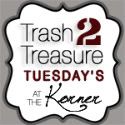As Adrienne’s husband, I support and appreciate Adrienne’s “humble”contribution to the shelter community; but as an intellectual property attorney, I would like to contribute some tips on legal issues affecting the impressive creative works and writings I see in the shelter community.
Consequently, I am establishing this additional column on our Adventures in DIY blog. While some may construe “adventures in DIY advocacy” to mean the adventures and challenges of representing oneself in advocating their legal rights (“do-it-yourself advocacy”), the title actually refers to the adventures and challenges of understanding the various intellectual property legal issues affecting the field of “do-it-yourself” home projects. After all, as a lawyer aware of the intricacies, nuances and potential traps in our legal system, I would rarely suggest and support do-it-yourself legal advocacy. Therefore, the reader should be advised that the content in this column is intended to be general in nature, does not constitute any specific legal advice or an attorney-client relationship, and readers requiring additional information or advice tailored to their particular situation should consult with their own attorney. Today’s column endeavors to answer the following commonly asked questions concerning the legal issues pertaining to DIY blogs.
1. What is “intellectual property?”
Intellectual Property (“IP”) typically refers to four main types of property rights based upon our “intellectual” efforts. These are 1) patents; 2) copyrights; 3) trademarks; and 4) trade secrets. A catch-all, miscellaneous type of intellectual property exists in the form of being able to sue another for“unfair competition” when one believes their business has been injured but the source of that injury is not considered an infringement on one of the above-referenced forms of intellectual property.
The first three IP rights are governed by federal statutes while trade secrets and unfair competition are governed by state law. Patent and Copyright rights are actually in our Constitution: “The Congress shall have Power To ... promote the Progress of Science and useful Arts, by securing for limited Times to Authors and Inventors the exclusive Right to their respective Writings and Discoveries;...” (Article I, Section 8).
- Patents – a patent is a right established in the U.S. Constitution and granted by the U.S. Patent and Trademark Office (“USPTO”) to an inventor “to exclude others from making, using, offering for sale, or selling a particular invention throughout the United States, or importing the invention into the U.S.,” for a limited time in exchange for public disclosure of the invention when the patent is granted. The limited time is usually about 17 to 20 years. The typical patent is a “utility” patent which covers any “useful process, machine, article of manufacture, or composition of matter, or any new and useful improvement thereof.” However, a “design patent” can be procured from the USPTO for any new, original, and ornamental design, usually of a particular product. A patent requires that the invention is “novel” (never before been achieved) and not“obvious” from any existing invention or known technology. Thus, a patent is extremely powerful because it provides an exclusive right to offer an entire product – i.e. a monopoly - but only for a limited amount of time and only if truly new to the market.
- Trademark (service mark) - A trademark is “a word, phrase, symbol, or design, or a combination thereof,” that identifies and distinguishes the source of the goods of one party from those of another. A service mark is the same as a trademark but identifies and distinguishes the source of a service instead of goods. The term “trademark” is typically used to collectively refer to both trademarks and service marks (and will be used as such throughout this blog). A trademark must therefore be associated with a particular product or service offered in commerce and only prevents the use of that name, symbol, phrase or design from being used with a later seller’s similar product or service in order to prevent consumers from being confused about who originally offers that product/service. A trademark right does not necessarily stop the sale of another product outright. One establishes a right to a trademark as soon as the mark is used on a product or service in commerce, but registering the mark with the U.S. Patent and Trademark Office or a particular state government helps to protect that trademark and enforce it against infringement.
- Copyright – A Copyright is a form of protection also established in the U.S. Constitution and federal laws for the authors of “original works of authorship” “fixed in a tangible medium of expression” such as literary, dramatic, musical, artistic and other intellectual works. A Copyright prevents another from directly copying one’s original work if recorded in some tangible form, such as a writing or drawing, an audio or video recording, an architectural rendering or a live performance and it does not matter if the tangible form is handwritten or typed, published or unpublished, electronic or on paper. However, copyright infringement requires that the copy be virtually an exact copy, not merely the idea or concept expressed in the work. The Copyright right is established immediately upon creation of the work, if the work is sufficiently original, and does not need any registration or grant by the government. However, registration with the U.S. Copyright Office, a part of the Library of Congress, is necessary in order to sue another for infringement and also to collect a greater amount of damages set forth in the law, known as “statutory damages.”
- Trade Secret – A trade secret is basically like it sounds – a secret of the business which provides that business with a competitive advantage and in which efforts to keep that secret from being disclosed can be demonstrated. Anyone who discloses such a secret can be liable for damages caused to the owner of that secret. Naturally, this assumes certain facts: 1) the secret is not generally known, published or otherwise easily ascertainable by anyone; 2) disclosing that secret will cause economic damage to the business that owns it; 3) the owner endeavors to prevent the disclosure of that secret, i.e. by having employees or others in the business knowledgeable about the secret sign a non-disclosure agreement; and 4) to enforce a trade secret, the owner of the trade secret must sue the discloser of that secret and prove the aforementioned facts. Usually state law and court precedents govern this type of protection. Some famous trade secrets include the formulas for making Coca-Cola and Kentucky Fried Chicken.
There are a number of other rules, regulations and requirements associated with these rights and their enforcement, as well as exceptions such as First Amendment free speech rights and rules promoting fair competition. For instance, one cannot expect to be able to prevent others from using a term to identify their product that is commonly understood as describing that type of product; and one is permitted to copy a brief excerpt of a Copyrighted work in order to refer to it in a noncommercial context such as the news. Also, these laws differ in each country and if not federal, from one state to another. That is why it is strongly recommended that one consult a lawyer about their particular situation if they believe their intellectual property right has been affected by another.
2. Do I have intellectual property rights in my blogs and in any of my contributions to mine or others’ blogs? If so, what are these “intellectual property” rights?
As one can probably tell from the explanation above, the most obvious and common IP right in these blogs are the Copyright of the content of these blogs and one’s contributions to another’s blog if sufficiently original. That content can be one’s written description of how the project is achieved; any pictures, photos, videos or audio recordings in the blog; the arrangement and design of the blog; and perhaps the source code for any computer programs designed to operate on the blog or its hosting web site. But a blogger cannot expect Copyright protection to prevent another from writing about the very same project that was described in their blog if the other blog describes that project in their own words, with their own pictures and with other original features. Also, Copyright protection probably should not prevent one from quoting a small portion of a blog in one's own blog or another work in order to discuss that quoted section, although the source of that quote should be identified. When contributing to another blog, it may be possible that the blog receiving the contribution receives some ownership interest or right to use your Copyrighted contribution. Another common IP right for a blog might be its trademark if that mark uniquely points to the particular source of the blog and identifies who produces it. A blog is typically considered a service – providing information to others and a forum for exchanging ideas. If the name of that blog is unique and does not describe any particular feature, function or targeted audience for the blog, and the users/readers of that blog therefore know that blog by its unique name, then that name can be considered a trademark (or service mark). If a subsequent blog or related service (e.g. a newsletter, webcast or other content provider) decides to use that same name or something sufficiently similar when conveying the same or similar information, and users/readers are confused about who produces which blog or related content because the marks are so similar, that trademark may be said to be infringed. The blogger with the first use of that mark then gets to prevent the subsequent use of that mark on the related service and could collect monetary damages for any profits proven to have been lost because of that infringement. That mark could consist of a name or phrase, a logo or possibly even a unique color or design pattern on the blog or web site and the marks need only be similar in sight, sound or meaning; the marks do not need to be identical. The only scenarios in which I can envision the blog owning a patent right would be if the blog discusses or refers to a particular invention or process that it owns and has patented, or the web site contains a certain computer program or functionality which also would be patented. It’s hard for me to imagine what trade secret a blogger or DIY content provider might own but perhaps one example might involve a site requiring a paid subscription. If a subsequent blogger or content provider obtains the confidential subscriber list for the first blog or web site and uses that subscriber list without the consent and knowledge of the first blogger to “steal” subscribers who subsequently subscribe to its later blog, the subsequent blogger could be shown to have stolen a trade secret when it stole the subscriber list.
These are just a few examples of possible IP rights believed to be associated with DIY home project blogs.
If you can think of others to suggest or would like to ask about a particular scenario, feel free to contact Alex on our Adventures in DIYblog.
Alex Butterman is a trademark attorney with Staas& Halsey LLP (http://www.staasandhalsey.com), a Washington, D.C. IP boutique law firm, and a former trademark examining attorney at the U.S. Patent and Trademark Office. Alex has been assisting U.S. and foreign businesses of all sizes in a wide variety of industries in intellectual property matters since 1995. Alex is admitted to the bars of Washington, D.C., New York and New Jersey and also is an active member of the International Trademark Association. Alex can be contacted at work directly by e-mailing him at abutterman@s-n-h.com. The opinions expressed are those of the author and do not necessarily reflect the views of Adrienne, his firm, its clients or Adventures in DIY. This article is for general information purposes and is not intended to be and should not be taken as legal advice.
Linking to:
Savvy Southern Style



















































